| Saint-Cyr House | |
|---|---|
.jpg.webp) The Saint-Cyr House (centre) with its two neighbours | |
| General information | |
| Type | Town house |
| Architectural style | Art Nouveau |
| Address | Square Ambiorix / Ambiorixsquare 11 |
| Town or city | B-1000 City of Brussels, Brussels-Capital Region |
| Country | Belgium |
| Coordinates | 50°50′52″N 4°23′02″E / 50.84778°N 4.38389°E |
| Construction started | February 1901 |
| Completed | July 1903 |
| Client | George Léonard de Saint-Cyr |
| Design and construction | |
| Architect(s) | Gustave Strauven |
| Designations | Protected (08/08/1988) |
| References | |
| [1] | |
The Saint-Cyr House[2] (French: Maison Saint-Cyr, Dutch: Huis Saint-Cyr) is a historic town house in Brussels, Belgium. It was designed by the architect Gustave Strauven, and built between 1901 and 1903, in Art Nouveau style. It is Strauven's most important building, and served as a private residence for the painter and decorator George Léonard de Saint-Cyr.[1]
The house is located at 11, square Ambiorix/Ambiorixsquare in the Squares Quarter (eastern part of the City of Brussels).[1] It is served by the bus stop Ambiorix (on lines 56, 60, 63 and 64).[3]
History
The Saint-Cyr House was designed and built by the architect Gustave Strauven, who began his career as an assistant designer working with Victor Horta. It was built to serve as a private residence for the painter and decorator George Léonard de Saint-Cyr. Work began in February 1901 and the house was declared complete by the City of Brussels in July 1903.[1]
Always coveted by architecture enthusiasts, the building, listed as a historic monument on 8 August 1988,[1] has had several owners. In 1909, the Leurs family, a pawnbroker, bought it from the painter. The dancer Chamie Lee acquired it in the 1950s and transformed the ground floor into a dance hall for her classes. An antique dealer from Etterbeek became the owner in 2003 to resell it in 2006 to the Antwerp agency Movast, specialising in historic buildings.[4] The house had been in a poor state of repair, but as of March 2013, has been restored to its former splendour by the architect Francis Metzger, from the architectural office MA² - Metzger et Associés Architecture.[5]
Description
The Saint-Cyr House is only 4 metres (13 ft) wide, but is given extraordinary height by his elaborate architectural inventions.[1] The façade, marked by a flamboyant Art Nouveau style, is entirely covered by polychrome bricks and has a good deal of wrought iron, which is adorned with geometric motifs and ornate balustrades at each floor. The wrought iron mimics vegetation and the decorative elements occupy all the space available. Due to its extravagance, the building has been called Art Nouveau-Baroque.[6] The interior is characterised by different styles, varying according to the rooms.[1]
 Entrance fence
Entrance fence Wrought iron balconies
Wrought iron balconies Gable
Gable
See also
References
Citations
- 1 2 3 4 5 6 7 Région de Bruxelles-Capitale (2006–2008). "Maison de Saint Cyr" (in French). Brussels. Retrieved 28 July 2022.
- ↑ "Saint-Cyr House". www.visit.brussels. Retrieved 9 September 2023.
- ↑ "Recherche - STIB Mobile". m.stib.be. Retrieved 30 July 2022.
- ↑ "La maison Saint-Cyr, joyau Art Nouveau, bientôt transformée en hôtel de luxe". Le Soir (in French). Retrieved 28 July 2022.
- ↑ "Maison Saint-Cyr". MA² - Metzger et Associés Architecture (in French). Retrieved 28 July 2022.
- ↑ Culot & Pirlot 2005, p. 87.
Bibliography
- Culot, Maurice; Pirlot, Anne-Marie (2005). Bruxelles Art Nouveau (in French). Brussels: Archives d'Architecture Moderne. ISBN 978-2-87143-126-8.
External links
 Media related to Hotel Saint-Cyr at Wikimedia Commons
Media related to Hotel Saint-Cyr at Wikimedia Commons